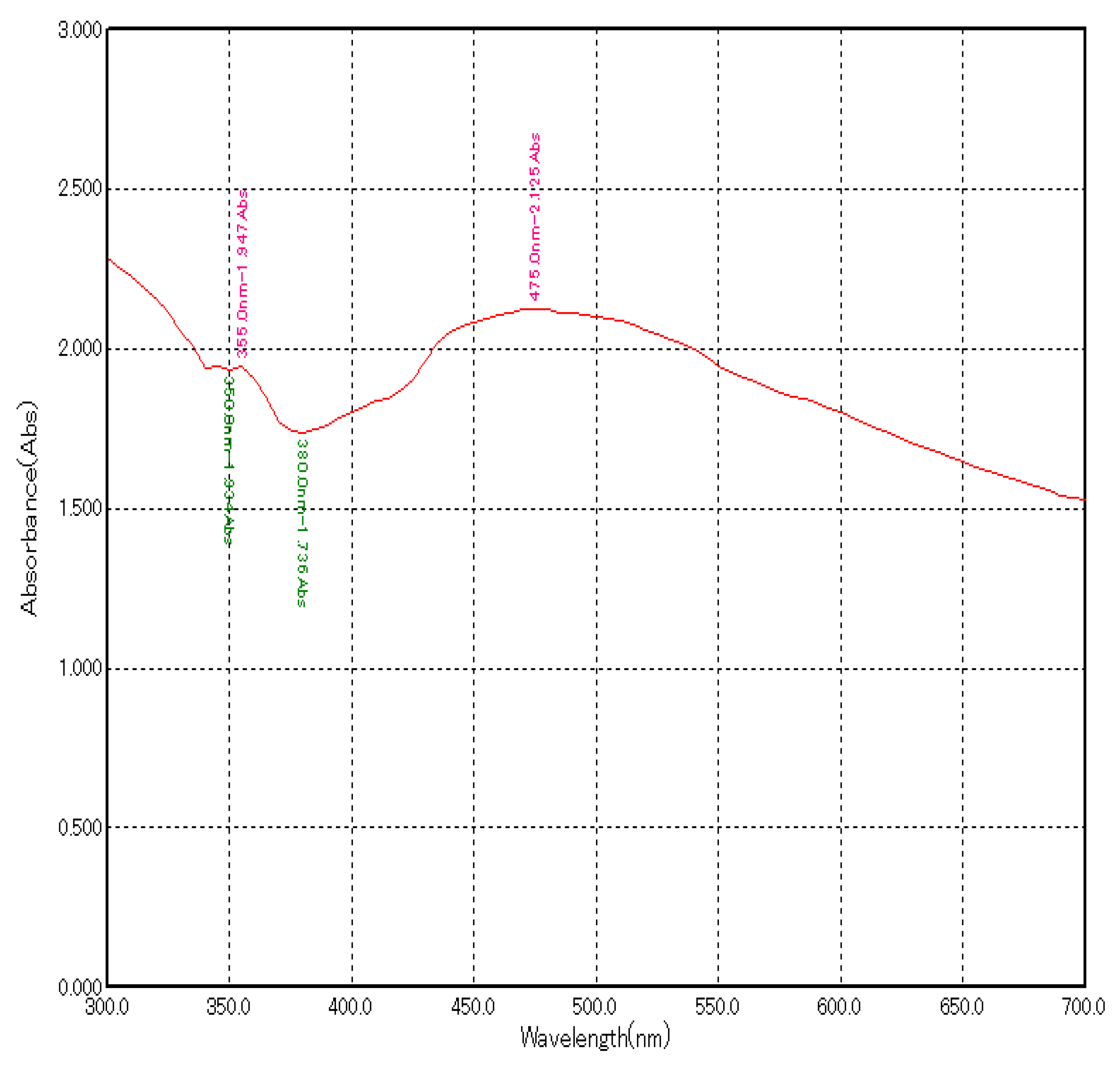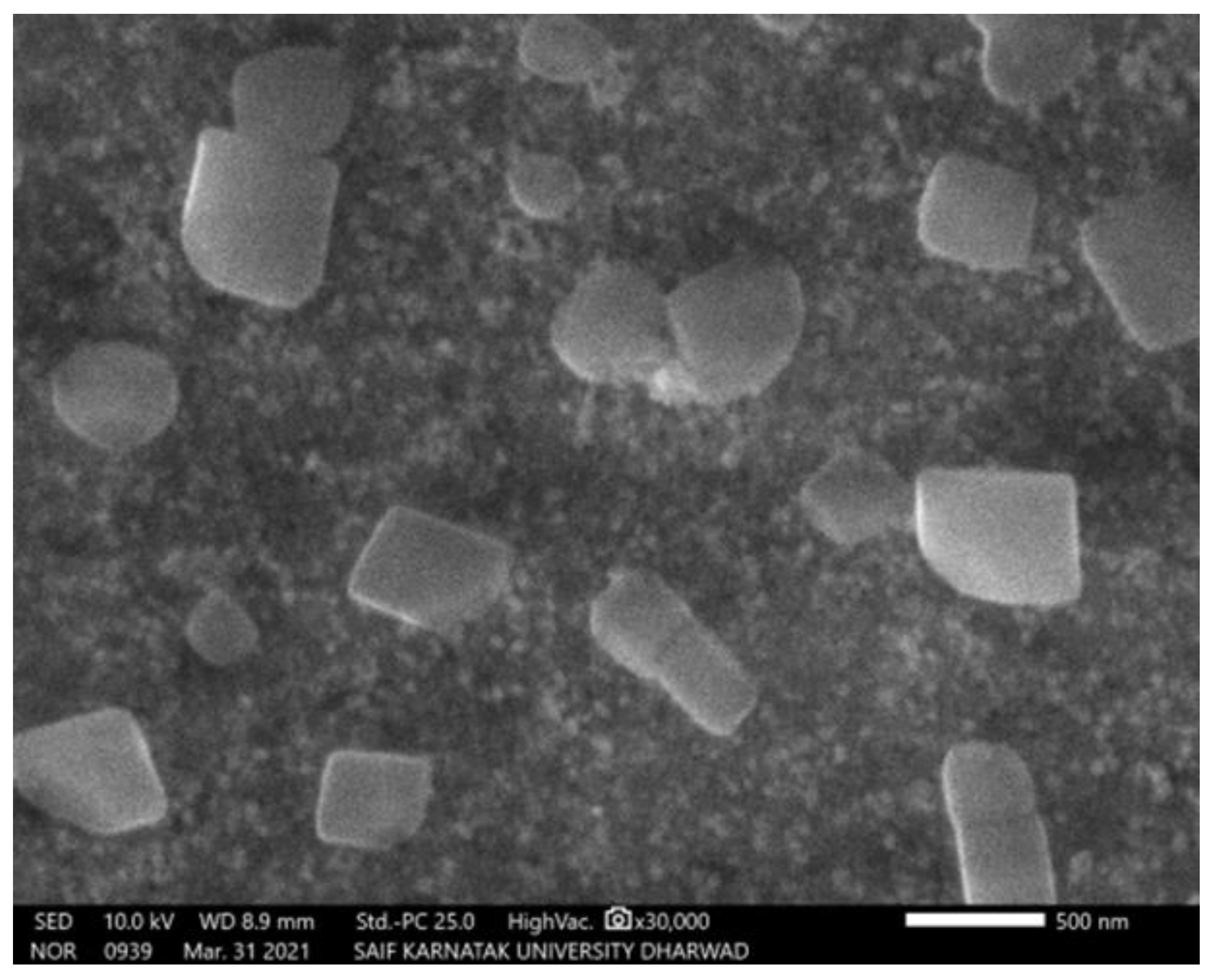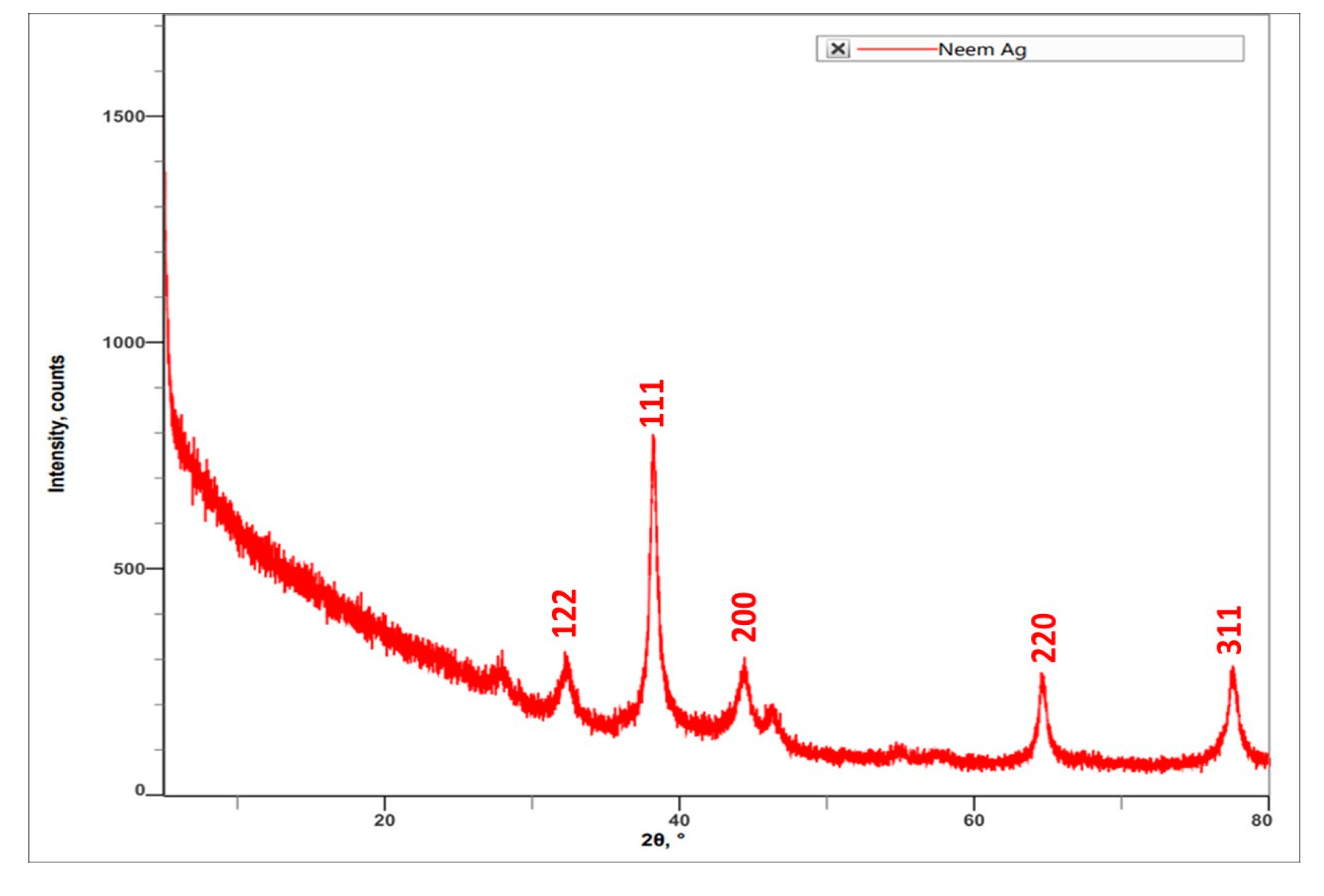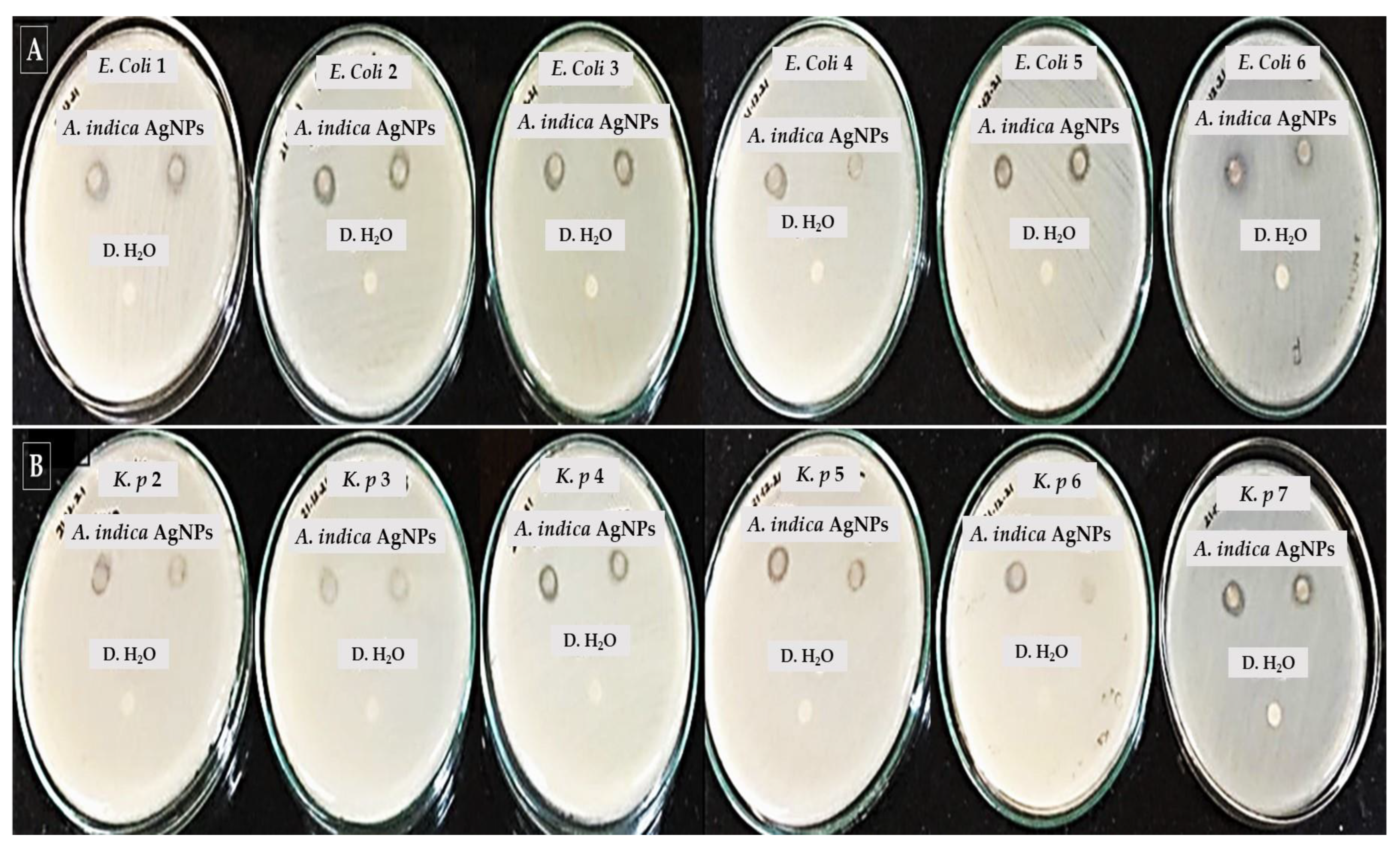In Vitro Antibacterial Activity of Green Synthesized Silver Nanoparticles Using Azadirachta indica Aqueous Leaf Extract against MDR Pathogens
Abstract
1. Introduction
2. Result and Discussion
2.1. Green Synthesis of Silver Nanoparticles from A. indica Leaf Extract
2.2. Characterization of Green Synthesized AgNPs
2.2.1. UV-Visible Absorption Spectrum of Green Synthesized AgNPs
2.2.2. Particle Size Distribution Study by Particle Size Analyser (PSA)
2.2.3. SEM Micrographs of Green Synthesized AgNPs
2.2.4. XRD Spectrum Obtained for A. indica Leaf Extract-Mediated AgNPs
2.3. To Study the Impact of Silver Nanoparticles on Physiological and Biochemical Changes in Rice Infected with M. oryzae
2.3.1. Superoxide Dismutase (SOD)
2.3.2. Catalase (CAT)
2.3.3. Peroxidase (POX)
2.3.4. Glutathione Reductase (GR)
2.3.5. Phenylalanine Ammonia-Lyase (PAL)
2.3.6. Reducing Sugar
2.3.7. Total Phenol
2.3.8. Antibacterial Studies against MDRs
2.4. Green Synthesis of AgNPs Using A. indicia and Their Characterization
2.5. To Study the Impact of AgNPs on Physiological and Biochemical Changes in Rice Infected with M. oryzae
2.5.1. Superoxide Dismutase (SOD)
2.5.2. Catalase (CAT)
2.5.3. Peroxidase (POX)
2.5.4. Glutathione Reductase
2.5.5. Phenylalanine Ammonia-Lyase
2.5.6. Reducing Sugars
2.5.7. Total Phenol
3. Materials and Methods
3.1. Experimental Treatment Details
3.2. Green Synthesis and Characterization of AgNPs Using A. indica Leaf Extract
3.3. Preparation of the A. indica Aqueous Leaf Extract
3.4. Preparation of AgNO3 Solution
3.5. Green Synthesis of AgNPs Using A. indica Aqueous Leaf Extract
3.6. Characterization of Green Synthesized AgNPs
3.7. Plant Sample
3.8. Extraction of Enzyme and Determination of Protein Content
3.9. Biochemical Assays
3.9.1. Superoxide Dismutase Activity
3.9.2. Catalase Activity
3.9.3. Peroxidase Activity
3.9.4. Glutathione Reductase Activity
3.9.5. Phenylalanine Ammonia Lyase Activity
3.9.6. Estimation of Total Phenols
3.9.7. Estimation of Reducing Sugars
3.10. Bacterial Strains Used in This Study
3.11. In Vitro Antibiotic Susceptibility Test of Green Synthesized AgNPs against MDR Bacteria
Disc Diffusion Method
3.12. Statistical Analysis
4. Conclusions
Author Contributions
Funding
Institutional Review Board Statement
Informed Consent Statement
Data Availability Statement
Acknowledgments
Conflicts of Interest
Sample Availability
References
- Thuesombat, P.; Hannongbua, S.; Akasit, S.; Chadchawan, S. Ecotoxicology and Environmental Safety Effect of Silver Nanoparticles on Rice (Oryza sativa L. Cv. KDML 105) Seed Germination and Seedling Growth. Ecotoxicol. Environ. Safety 2014, 104, 302–309. [Google Scholar] [CrossRef] [PubMed]
- Larue, C.; Castillo-Michel, H.; Sobanska, S.; Cécillon, L.; Bureau, S.; Barthès, V.; Ouerdane, L.; Carrière, M.; Sarret, G. Foliar exposure of the crop Lactuca sativa to silver nanoparticles: Evidence for internalization and changes in Ag speciation. J. Hazard. Mater. 2014, 264, 98–106. [Google Scholar] [CrossRef] [PubMed]
- Kuchekar, S.R.; Patil, M.P.; Gaikwad, V.B.; Han, S.H. Synthesis and Characterization of Silver Nanoparticles Using Azadirachtaindica (Neem) Leaf Extract. Int. J. Eng. 2017, 6, 47–55. [Google Scholar]
- Veerasamy, R.; Xin, T.Z.; Gunasagaran, S.; Xiang, T.F.W.; Yang, E.F.C.; Jeyakumar, N.; Dhanaraj, S.A. Biosynthesis of silver nanoparticles using mangosteen leaf extract and evaluation of their antimicrobial activities. J. Saudi Chem. Soc. 2011, 15, 113–120. [Google Scholar] [CrossRef]
- Salve, P.; Vinchurkar, A.; Raut, R.; Chondekar, R.; Lakkakula, J.; Roy, A.; Hossain, J.; Alghamdi, S.; Almehmadi, M.; Abdulaziz, O.; et al. An Evaluation of Antimicrobial, Anticancer, Anti-Inflammatory and Antioxidant Activities of Silver Nanoparticles Synthesized from Leaf Extract of Madhuca longifolia Utilizing Quantitative and Qualitative Methods. Molecules 2022, 27, 6404. [Google Scholar] [CrossRef] [PubMed]
- Taifa, S.; Muhee, A.; Bhat, R.A.; Nabi, S.U.; Roy, A.; Rather, G.A. Mallick Evaluation of Therapeutic Efficacy of Copper Nanoparticles in Staphylococcus aureus-Induced Rat Mastitis Model. J. Nanomater. 2022, 2022, 7124114. [Google Scholar] [CrossRef]
- Kanmani, N. Biosynthesis of Silver Nanoparticles and Their Evaluation of Antifungal Activity against Magnaporthe oryzae. J. Pharmacogn. Phytochem. 2018, 7, 1638–1648. [Google Scholar]
- Barage, S.; Lakkakula, J.; Sharma, A.; Roy, A.; Alghamdi, S.; Almehmadi, M.; Hossain, J.; Allahyani, M.; Abdulaziz, O. Nanomaterial in Food Packaging: A Comprehensive Review. J. Nanomater. 2022, 2022, 6053922. [Google Scholar] [CrossRef]
- Muhammad, D.R.A.; Gonzalez, C.G.; Doost, A.S.; Van de Walle, D.; Van der Meeren, P.; Dewettinck, K. Improvement of Antioxidant Activity and Physical Stability of Chocolate Beverage Using Colloidal Cinnamon Nanoparticles. Food Bioprocess Technol. 2019, 12, 976–989. [Google Scholar] [CrossRef]
- Shukla, V.K.; Pandey, S.; Pandey, A.C. Green Synthesis of Silver Nanoparticles Using Neem Leaf (Azadirachta indica) Extract. Int. Conf. Adv. Nanomater. Nanotechnol. 2009, 1276, 43–49. [Google Scholar] [CrossRef]
- Elumalai, E.K.; Prasad, T.N.V.K.V.; Venkata, K.; Nagajyothi, P.C.; David, E. Green Synthesis of Silver Nanoparticle Using Euphorbia Hirta L and Their Antifungal Activities. Arch. Appl. Sci. Res. 2010, 2, 76–81. [Google Scholar]
- Mahakham, W.; Sarmah, A.K.; Maensiri, S.; Theerakulpisut, P. Nanopriming technology for enhancing germination and starch metabolism of aged rice seeds using phytosynthesized silver nanoparticles. Sci. Rep. 2017, 7, 8263. [Google Scholar] [CrossRef] [PubMed]
- Ghozali, S.Z.; Vuanghao, L.; Ahmad, N.H. Biosynthesis and Characterization of Silver Nanoparticles Using Catharanthus roseus Leaf Extract and Its Proliferative Effects on Cancer Cell Lines. J. Nanomed. Nanotechnol. 2015, 6, 4–11. [Google Scholar]
- Bhusnure, O.G.; Kuthar, V.S.; Gholve, S.B.; Giram, P.S.; Shembekar, V.S.; Zingade, S.G.; Jadhav, P.P. Green Synthesis of Silver Nanoparticle Using Catharanthus roseus Extract for Pharmacological Activity. Int. J. Pharma Pharm. Res. 2017, 10, 77–88. [Google Scholar]
- Dubey, S.P.; Lahtinen, M.; Sillanpää, M. Tansy fruit mediated greener synthesis of silver and gold nanoparticles. Process Biochem. 2010, 45, 1065–1071. [Google Scholar] [CrossRef]
- Jagtap, U.; Bapat, V.A. Green Synthesis of Silver Nanoparticles Using Artocarpus heterophyllus Lam. Seed Extract and Its Antibacterial Activity. Ind. Crops Prod. 2013, 46, 132–137. [Google Scholar] [CrossRef]
- Prabha, S.; Durgalakshmi, D.; Subramani, K.; Aruna, P.; Ganesan, S. Enhanced Emission of Zinc Nitride Colloidal Nanoparticles with Organic Dyes for Optical Sensors and Imaging Application. ACS Appl. Mater. Interfaces 2020, 12, 19245–19257. [Google Scholar] [CrossRef]
- Kora, A.J.; Arunachalam, J. Biosynthesis of Silver Nanoparticles by the Seed Extract of Strychnos potatorum: A Natural Phytocoagulant. IET Nanobiotechnol. 2013, 7, 83–89. [Google Scholar] [CrossRef]
- Foyer, C.; Noctor, G. Oxidant and Antioxidant Signaling in Plants, a Reevaluation of the Concept of Oxidative Stress in a Physiological Context. Plant Cell Environ. 2005, 28, 1056–1071. [Google Scholar] [CrossRef]
- Alscher, R.G.; Erturk, N.; Heath, L.S. Role of superoxide dismutases (SODs) in controlling oxidative stress in plants. J. Exp. Bot. 2002, 53, 1331–1341. [Google Scholar] [CrossRef]
- Krishnaraj, C.; Jagan, E.G.; Ramachandran, R.; Abirami, S.M.; Mohan, N.; Kalaichelvan, P.T. Effect of Biologically Synthesized Silver Nanoparticles on Bacopa monnieri (Linn.) Wettst. Plant Growth Metabolism. Process Biochem. 2012, 47, 651–658. [Google Scholar] [CrossRef]
- Upadhyaya, H.; Begum, L.; Dey, B.; Nath, P.K.; Panda, S.K. Impact of Calcium Phosphate Nanoparticles on Rice Plant. J. Plant Sci. Phytopathol. 2017, 1, 001–010. [Google Scholar] [CrossRef]
- Cruz, C.M.H. Drought Stress and Reactive Oxygen Species: Production, Scavenging and Signaling. Plant Signal. Behav. 2008, 3, 156–165. [Google Scholar] [CrossRef] [PubMed]
- Miller, A.; Frey, G.; King, G.; Sunderman, C. A Handheld Electrostatic Precipitator for Sampling Airborne Particles and Nanoparticles. Aerosol Sci. Technol. 2010, 44, 417–427. [Google Scholar] [CrossRef]
- Gupta, S.D.; Agarwal, A.; Pradhan, S. Phytostimulatory effect of silver nanoparticles (AgNPs) on rice seedling growth: An insight from antioxidative enzyme activities and gene expression patterns. Ecotoxicol. Environ. Saf. 2018, 161, 624–633. [Google Scholar] [CrossRef] [PubMed]
- Lamport, D.T.A. Roles of Peroxidases in Cell Wall Genesis. In Molecular and Physiological Aspects of Plant Peroxidases; Greppin, H., Penel, C., Gasper, T., Eds.; University of Geneva Press: Geneva, Switzerland, 1986. [Google Scholar]
- Lüthje, S.; Meisrimler, C.-N.; Hopff, D.; Möller, B. Phylogeny, topology, structure and functions of membrane-bound class III peroxidases in vascular plants. Phytochemistry 2011, 72, 1124–1135. [Google Scholar] [CrossRef]
- Ye, X.; Ng, T. Isolation of a novel peroxidase from French bean legumes and first demonstration of antifungal activity of a non-milk peroxidase. Life Sci. 2002, 71, 1667–1680. [Google Scholar] [CrossRef]
- Ghosh, M. Antifungal Properties of Haem Peroxidase from Acorus calamus. Ann. Bot. 2006, 98, 1145–1153. [Google Scholar] [CrossRef]
- Noori, A.; Donnelly, T.; Colbert, J.; Cai, W.; Newman, L.A.; White, J.C. Exposure of Tomato (Lycopersicon esculentum) to Silver Nanoparticles and Silver Nitrate: Physiological and Molecular Response. Int. J. Phytoremediat. 2020, 22, 40–51. [Google Scholar] [CrossRef]
- Shigeoka, S.; Ishikawa, T.; Tamoi, M.; Miyagawa, Y.; Takeda, T.; Smith, L.M.; Boyko, E. Differtial Expression of Gene in Wheat Triticuma sevum controlled Resistance to the Russian Wheat Aphid, Diuaphis, Noxia (Mordviller). IOBC WPrS Bull. 2005, 28, 11–20. [Google Scholar]
- Yanik, F.; Vardar, F. Assessment of Silver Nanoparticle-Induced Morphological, Biochemical and Physiological Alterations in Wheat Roots. Ann. Bot. 2019, 9, 83–94. [Google Scholar]
- Lawton, M.A.; Lamb, C.L. Transcriptional Activation of Plant Defense Gene by Fungus Elicitor, Wonding, and Infection. Mol. Cell Bio. 1987, 7, 335–341. [Google Scholar]
- Dixon, R.A.; Dey, P.M.; Lamb, C.J. Phytoalexins: Enzymology and Molecular Biology. Adv. Enzymol. Relat. Areas Mol. Biol. 1983, 55, 1–136. [Google Scholar] [CrossRef]
- Morkunas, I.; Ratajczak, L. The Role of Suger signalling in Plant Defence Response against Fungal Pathogen. Acta Physiol. Plant 2014, 36, 1607–1619. [Google Scholar] [CrossRef]
- Maffei, M.E.; Mithöfer, A.; Boland, W. Insects feeding on plants: Rapid signals and responses preceding the induction of phytochemical release. Phytochemistry 2007, 68, 2946–2959. [Google Scholar] [CrossRef] [PubMed]
- MacRae, W.; Towers, G. Biological activities of lignans. Phytochemistry 1984, 23, 1207–1220. [Google Scholar] [CrossRef]
- Scalbert, A. Antimicrobial properties of tannins. Phytochemistry 1991, 30, 3875–3883. [Google Scholar] [CrossRef]
- Ahmed, T.; Shahid, M.; Noman, M.; Niazi, M.B.K.; Mahmood, F.; Manzoor, I.; Zhang, Y.; Li, B.; Yang, Y.; Yan, C.; et al. Silver Nanoparticles Synthesized by Using Bacillus cereus SZT1 Ameliorated the Damage of Bacterial Leaf Blight Pathogen in Rice. Pathogens 2020, 9, 160. [Google Scholar] [CrossRef]
- Roseline, T.A.; Sudhakar, M.P.; Kulanthaiyesu, A. Synthesis of Silver Nanoparticle Composites Using Calliblepharis fimbriata Aqueous Extract, Phytochemical Stimulation, and Controlling Bacterial Blight Disease in Rice. ACS Agric. Sci. Technol. 2021, 1, 702–718. [Google Scholar] [CrossRef]
- Roy, P.; Das, B.; Mohanthy, A.; Mohapatra, S. Green Synthesis of Silver Nanoparticles Using Azadirachta indica leaf Extract and Its Antimicrobial Study. Appl. Nanosci. 2017, 7, 843–850. [Google Scholar] [CrossRef]
- Tantray, J.A.; Mansoor, S.; Wani, R.F.C.; Nissa, N.U. Protein Estimation by Lowry’s Method. In Basic Life Science Methods; Elsevier: Amsterdam, The Netherlands, 2022; pp. 65–67. [Google Scholar]
- Peltonen, S.; Karjalainen, R. Phenylalanine Ammonia Lyase Activity in Barlay after Infection with BipolarisSorokiniana or Treatment with Its Purified Baralay. J. Phytopathol. 1995, 143, 239–245. [Google Scholar] [CrossRef]
- Beauchamp, C.; Fridovich, I. Superoxide dismutase: Improved assays and an assay applicable to acrylamide gels. Anal. Biochem. 1971, 44, 276–287. [Google Scholar] [CrossRef]
- Beers, R.F.; Sizer, I.W. A Spectrophotometric Method for Measuring the Breakdown of Hydrogen Peroxide by Catalase. J. Biol. Chem. 1952, 195, 133–140. [Google Scholar] [CrossRef]
- Mavis, R.D.; Stellwagen, E. The Role of Cations in Yeast Phosphofructokinase Catalysis. J. Biol. Chem. 1970, 245, 674–680. [Google Scholar] [CrossRef]
- Nelson, N. A photometric adaptation of the Somogyi method for the determination of glucose. J. Biol. Chem. 1944, 153, 375–380. [Google Scholar] [CrossRef]
- Folin, O.; Wu, H. A Revised Colorimetric Method for Determination of Uric Acid in Urine. J. Biol. Chem. 1919, 38, 459–460. [Google Scholar] [CrossRef]
- Ganesan, D.; Al-Sayed, E.; Albert, A.; Paul, E.; Singab, A.N.B.; Sadasivam, S.G.; Saso, L. Antioxidant activity of phenolic compounds from extracts of Eucalyptus globulus and Melaleuca styphelioides and their protective role on D-glucose-induced hyperglycemic stress and oxalate stress in NRK-49Fcells. Nat. Prod. Res. 2018, 32, 1274–1280. [Google Scholar] [CrossRef]
- Bray, H.G.; Thorpe, W.V. Analysis of Phenolic Compounds of Interest in Metabolism. Methods Biochem. Anal. 1954, 1, 27–52. [Google Scholar] [CrossRef]
- Mitra, S.D.; Sebastian, S.C.; Rekha, I.; Irshad, P.; Mudigonda, A.; Suresh, J.; Choudhary, S.; Tewari, R.; Ganaie, F.; Shome, B.R. Molecular detection of the New Delhi metallo-β-lactamase clinical variant with double mutation- V88L and M154L in Escherichia coli isolates from South India. Gene Rep. 2020, 21, 100880. [Google Scholar] [CrossRef]
- Tewari, R.; Ganaie, F.; Venugopal, N.; Mitra, S.; Shome, R.; Shome, B.R. Occurrence and characterization of genetic determinants of β-lactam-resistance in Escherichia coli clinical isolates. Infect. Genet. Evol. 2022, 100, 105257. [Google Scholar] [CrossRef]
- Bauer, M.A.W.; Kirby, M.W.M.M.; Sherris, M.J.C.; Turck, M.M. Antibiotic Susceptibility Testing by a Standardized Single Disk Method. Am. J. Clin. Pathol. 1966, 45, 493–496. [Google Scholar] [CrossRef] [PubMed]
- Gomez, K.A.; Gomez, A.A. Statistical Procedures for Agricultural Research, 2nd ed.; John Wiley & Sons: Nashville, TN, USA, 1984; ISBN 9780471870920. [Google Scholar]






| Treatment | Activity of Superoxide Dismutase (U/mg Protein) | % Variation Compared with T1 |
|---|---|---|
| Control | 19.08 | - |
| T1: 0 ppm AgNPs (DC) | 23.79 # | - |
| T2: 05 ppm AgNPs | 24.09 | 1.26 |
| T3: 10 ppm AgNPs | 25.60 * | 7.61 |
| T4: 15 ppm AgNPs | 27.86 * | 17.11 |
| T5: 20 ppm AgNPs | 28.59 * | 20.18 |
| T6: 30 ppm AgNPs | 30.69 * | 29.00 |
| T7: 50 ppm AgNPs | 34.02 * | 43.00 |
| C.D. | 2.836 | |
| S.E(m) | 0.938 | |
| Treatment | Activity of Catalase (U/mg Protein) | % Variation Compared with T1 |
|---|---|---|
| Control | 19.2 | - |
| T1: 0 ppm AgNPs (DC) | 26.63 # | - |
| T2: 05 ppm AgNPs | 26.88 | 0.94 |
| T3: 10 ppm AgNPs | 27.02 | 1.46 |
| T4: 15 ppm AgNPs | 28.56 * | 7.25 |
| T5: 20 ppm AgNPs | 30.63 * | 15.02 |
| T6: 30 ppm AgNPs | 32.60 * | 22.42 |
| T7: 50 ppm AgNPs | 37.20 * | 39.69 |
| C.D. | 2.531 | |
| S.E(m) | 0.837 | |
| Treatment | Activity of Peroxidase (U/mg Protein) | % Variation Compared with T1 |
|---|---|---|
| Control | 0.803 | - |
| T1: 0 ppm AgNPs (DC) | 0.933 # | - |
| T2: 05 ppm AgNPs | 0.940 | 0.75 |
| T3: 10 ppm AgNPs | 0.979 * | 4.93 |
| T4: 15 ppm AgNPs | 0.988 * | 5.89 |
| T5: 20 ppm AgNPs | 0.992 * | 6.32 |
| T6: 30 ppm AgNPs | 1.118 * | 19.83 |
| T7: 50 ppm AgNPs | 1.194 * | 27.97 |
| C.D. | 0.087 | |
| S.E(m) | 0.029 | |
| Treatment | Activity of Glutathione Reductase (U/mg Protein) | % Variation Compared with T1 |
|---|---|---|
| Control | 0.60 | - |
| T1: 0 ppm AgNPs (DC) | 0.67 # | - |
| T2: 05 ppm AgNPs | 0.71 | 5.97 |
| T3: 10 ppm AgNPs | 0.73 | 8.96 |
| T4: 15 ppm AgNPs | 0.78 * | 16.42 |
| T5: 20 ppm AgNPs | 0.80 ** | 19.40 |
| T6: 30 ppm AgNPs | 0.89 ** | 32.84 |
| T7: 50 ppm AgNPs | 0.92 ** | 37.31 |
| S.E(m) | 0.027 | |
| C.D. | 0.082 | |
| Treatment | Activity of Phenylalanine Ammonia-Lyase (U/mg Protein) | % Variation Compared with T1 |
|---|---|---|
| Control | 1.25 | - |
| T1: 0 ppm AgNPs (DC) | 2.20 # | - |
| T2: 05 ppm AgNPs | 2.28 | 3.64 |
| T3: 10 ppm AgNPs | 2.36 | 7.27 |
| T4: 15 ppm AgNPs | 2.38 | 8.18 |
| T5: 20 ppm AgNPs | 2.46 | 11.82 |
| T6: 30 ppm AgNPs | 2.82 * | 28.18 |
| T7: 50 ppm AgNPs | 3.02 * | 37.27 |
| S.E(m) | 0.097 | |
| C.D. | 0.294 | |
| Treatment | Reducing Sugar (g% Dry Weight) | % Variation Compared with T1 |
|---|---|---|
| Control | 5.29 | - |
| T1: 0 ppm AgNPs (DC) | 3.01 # | - |
| T2: 05 ppm AgNPs | 3.96 * | 31.56 |
| T3: 10 ppm AgNPs | 4.02 * | 33.55 |
| T4: 15 ppm AgNPs | 4.31 * | 43.19 |
| T5: 20 ppm AgNPs | 5.35 * | 77.74 |
| T6: 30 ppm AgNPs | 5.95 * | 97.67 |
| T7: 50 ppm AgNPs | 6.29 * | 108.97 |
| S.E(m) | 0.225 | |
| C.D. | 0.682 | |
| Treatment | Total Phenol (g% of Dry Weight) | % Variation Compared with T1 |
|---|---|---|
| Control | 3.32 | - |
| T1: 0 ppm AgNPs (DC) | 4.29 # | - |
| T2: 05 ppm AgNPs | 4.58 | 6.76 |
| T3: 10 ppm AgNPs | 4.89 * | 13.99 |
| T4: 15 ppm AgNPs | 5.23 * | 21.91 |
| T5: 20 ppm AgNPs | 5.26 * | 22.61 |
| T6: 30 ppm AgNPs | 5.12 * | 19.35 |
| T7: 50 ppm AgNPs | 6.25 * | 45.69 |
| S.E(m) | 0.113 | |
| C.D. | 0.343 | |
| Bacteria | Diameter of Inhibition Zone (mm) | |
|---|---|---|
| AgNPs | ||
| 1. | ATCC 25922 E. coli | 12 |
| 2. | E. coli Ec1 | 11 |
| 3. | E. coli Ec2 | 12 |
| 4. | E. coli Ec3 | 11 |
| 5. | E. coli Ec4 | 12 |
| 6. | E. coli Ec5 | 12 |
| 7 | E. coli Ec6 | 13 |
| 8. | K. pneumoniae KP-1 | 11 |
| 9. | K. pneumoniae KP-2 | 11 |
| 10. | K. pneumoniae KP-3 | 13 |
| 11. | K. pneumoniae KP-4 | 12 |
| 12. | K. pneumoniae KP-5 | 12 |
| 13. | K. pneumoniae KP-6 | 13 |
| 14. | K. pneumoniae KP-7 | 12 |
| Treatment | Details |
|---|---|
| Control | 0 ppm AgNPs + no disease (Normal control) |
| T1 | 0 ppm AgNPs + diseased (Disease control-DC) |
| T2 | 05 ppm AgNPs + diseased |
| T3 | 10 ppm AgNPs + diseased |
| T4 | 15 ppm AgNPs + diseased |
| T5 | 20 ppm AgNPs + diseased |
| T6 | 30 ppm AgNPs + diseased |
| T7 | 50 ppm AgNPs + diseased |
Publisher’s Note: MDPI stays neutral with regard to jurisdictional claims in published maps and institutional affiliations. |
© 2022 by the authors. Licensee MDPI, Basel, Switzerland. This article is an open access article distributed under the terms and conditions of the Creative Commons Attribution (CC BY) license (https://creativecommons.org/licenses/by/4.0/).
Share and Cite
Alqahtani, O.; Mirajkar, K.K.; Kumar K R., A.; Mahnashi, M.H.; Shaikh, I.A.; Mitra, S.; Nagaraj, H.; More, S.S.; Muddapur, U.M.; Khan, A.A.; et al. In Vitro Antibacterial Activity of Green Synthesized Silver Nanoparticles Using Azadirachta indica Aqueous Leaf Extract against MDR Pathogens. Molecules 2022, 27, 7244. https://doi.org/10.3390/molecules27217244
Alqahtani O, Mirajkar KK, Kumar K R. A, Mahnashi MH, Shaikh IA, Mitra S, Nagaraj H, More SS, Muddapur UM, Khan AA, et al. In Vitro Antibacterial Activity of Green Synthesized Silver Nanoparticles Using Azadirachta indica Aqueous Leaf Extract against MDR Pathogens. Molecules. 2022; 27(21):7244. https://doi.org/10.3390/molecules27217244
Chicago/Turabian StyleAlqahtani, Omaish, Kiran K. Mirajkar, Anil Kumar K R., Mater H. Mahnashi, Ibrahim Ahmed Shaikh, Susweta Mitra, Harshitha Nagaraj, Sunil S. More, Uday M. Muddapur, Aejaz Abdullatif Khan, and et al. 2022. "In Vitro Antibacterial Activity of Green Synthesized Silver Nanoparticles Using Azadirachta indica Aqueous Leaf Extract against MDR Pathogens" Molecules 27, no. 21: 7244. https://doi.org/10.3390/molecules27217244
APA StyleAlqahtani, O., Mirajkar, K. K., Kumar K R., A., Mahnashi, M. H., Shaikh, I. A., Mitra, S., Nagaraj, H., More, S. S., Muddapur, U. M., Khan, A. A., & Sudarshan, P. R. (2022). In Vitro Antibacterial Activity of Green Synthesized Silver Nanoparticles Using Azadirachta indica Aqueous Leaf Extract against MDR Pathogens. Molecules, 27(21), 7244. https://doi.org/10.3390/molecules27217244







